DMRF-Funded Investigators Develop New Approach to Studying Motor Control

DMRF grantee Jesse Goldberg, MD, PhD, Associate Professor and Robert R. Capranica Fellow in the Department of Neurobiology and Behavior at Cornell University, has developed a groundbreaking new approach to studying dystonia and other movement disorders.
The study of dystonia has always required posing fundamental questions about how the human brain controls and coordinates movement. The act of reaching an arm to pick up an object is an incredibly complex neural task – and uncovering precisely what goes wrong in the brain when dystonia interferes with such a task is equally tricky. Much of what is known about human movement control and coordination has come from the study of reaching and grabbing in monkeys, because of the obvious similarities. Lab models such as mice, for example, do not have the anatomy or behavior to replicate human reaching with a limb.
However, Dr. Goldberg and his team discovered that the movements of a mouse’s tongue when it licks water from a spout are neurologically comparable to a primate reaching an arm to grab an object. While a hand reach and a mouse lick may not initially appear to have much in common, in both cases the brain must coordinate fine motor adjustments in relation to a specific target. The investigators designed experiments using water spouts fitted with sensors, high-speed cameras, and artificial intelligence applications capable of sifting through millions of image frames to track the mouse tongue movements. Additional techniques allowed the researchers to observe that the licking mice activated the brain’s motor cortex in remarkably similar ways to reaching primates. They demonstrated that a single mouse lick is controlled by the brain in a similar way to a human reach. This work opens up new opportunities to study the motor cortex function to understand normal movement as well as the neural basis of movement disorders like dystonia, Parkinson’s disease, and others. The hope is that this methodology will provide a best-in-class method for closely examining mouse motor control with the right level of precision to clarify behavioral abnormalities in dystonia mouse models, which are critical for strategizing and testing new treatment approaches.
DMRF is proud to have supported Dr. Goldberg’s lab in partnership with the Dorothy Feiss Scientific and Medical Research Fund.
The Dystonia Medical Research Foundation is a 501(c)(3) non-profit organization dedicated to advancing research for improved dystonia treatments and ultimately a cure, promoting awareness, and supporting the well-being of affected individuals and families.



